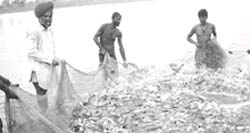Wealth from waste
 A scientific revolution is brewing. Not in the laboratories of the nation but in a 40-hectare farm in Hiatpur village in Ludhiana district of Punjab. Darshan Singh Tabiba, a farmer with basic elementary education, is the proud owner of the farm. Twenty years ago the farmland lay barren. Today, it is a resounding example of an individual's endeavour to make diversified farm practises more productive. Even the scientists of the Punjab Agricultural University (pau), Ludhiana, appreciate Tabiba's efforts. Starting from growing traditional crops such as rice and wheat, he profitably manages dairy farming, piggery, poultry, honey bee culture, agroforestry and horticulture.
A scientific revolution is brewing. Not in the laboratories of the nation but in a 40-hectare farm in Hiatpur village in Ludhiana district of Punjab. Darshan Singh Tabiba, a farmer with basic elementary education, is the proud owner of the farm. Twenty years ago the farmland lay barren. Today, it is a resounding example of an individual's endeavour to make diversified farm practises more productive. Even the scientists of the Punjab Agricultural University (pau), Ludhiana, appreciate Tabiba's efforts. Starting from growing traditional crops such as rice and wheat, he profitably manages dairy farming, piggery, poultry, honey bee culture, agroforestry and horticulture.
The farm is unique. It is a place where nothing goes waste, not even animal excreta. Waste from one activity is put to use in another, that too resourcefully. The poultry waste is used as pig feed. The pig excreta and dairy waste, on the other hand, are drained into a three-hectare pond as an addition to the fish feed. The pigsty is built near the pond's edge so that the urine, which has nitrogenous compounds such as ammonia, automatically flows into the pond. And the pond water is used for irrigation. "Thanks to the nitrogen enriched pond water, I use about 25 per cent less urea compared to other farmers harvesting the same yield,' says a proud Tabiba.
Tabiba is not only utilising his own waste but also the waste of the sugarcane industry. He is using pressmud
Related Content
- Production and promotion of organic and bio fertilisers with special focus on improving economic viability of gaushalas
- Waste-wise cities: best practices in municipal solid waste management
- Benefit sharing in the mining sector in Africa
- Regional overview of food security and nutrition: Europe and Central Asia 2018
- Recommendations for long term action plan for solid waste management in Delhi
- Regional overview of food insecurity: Europe and Central Asia
